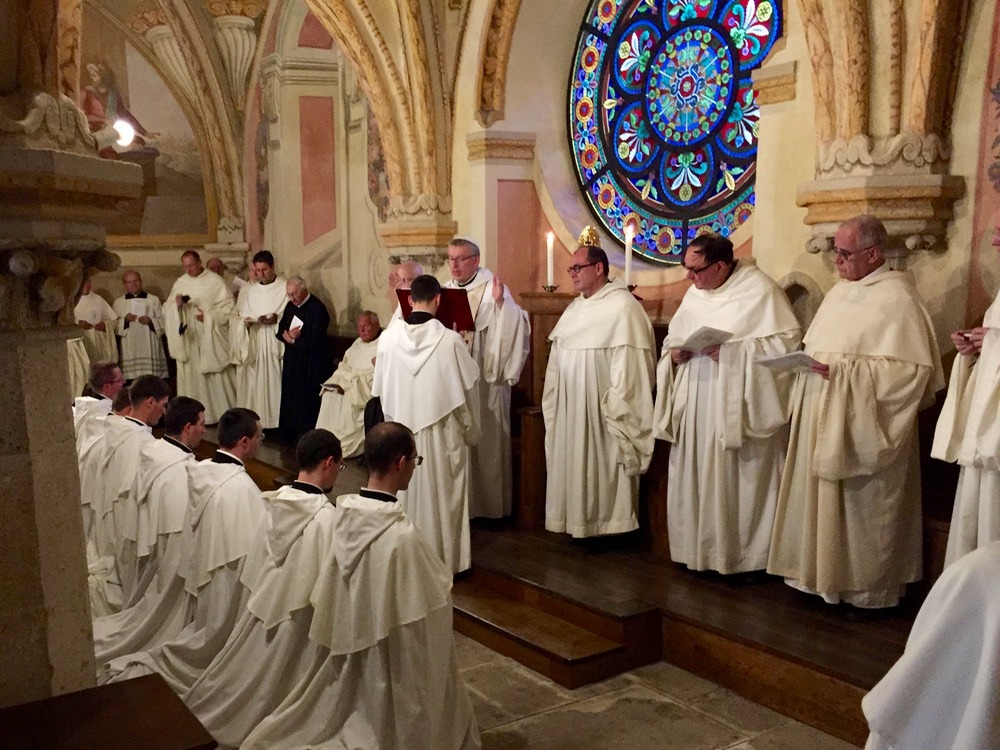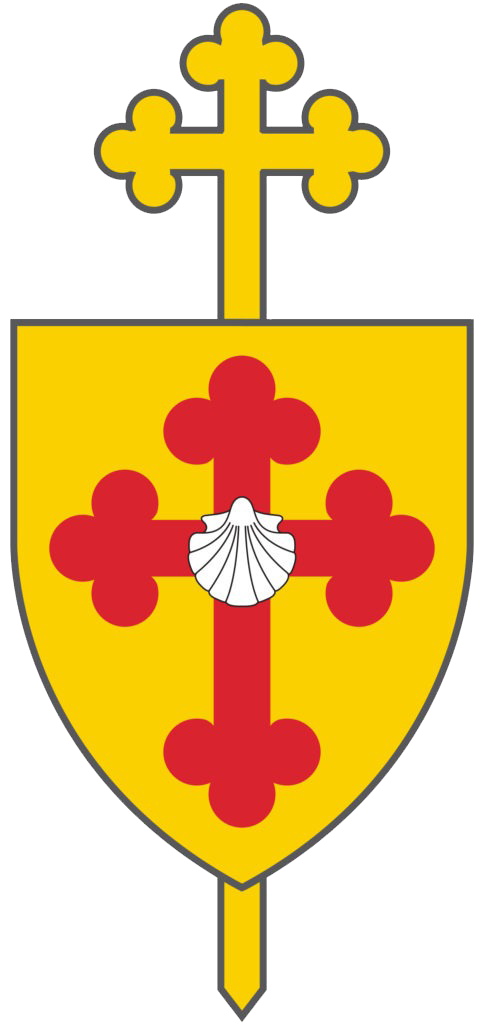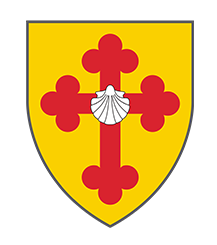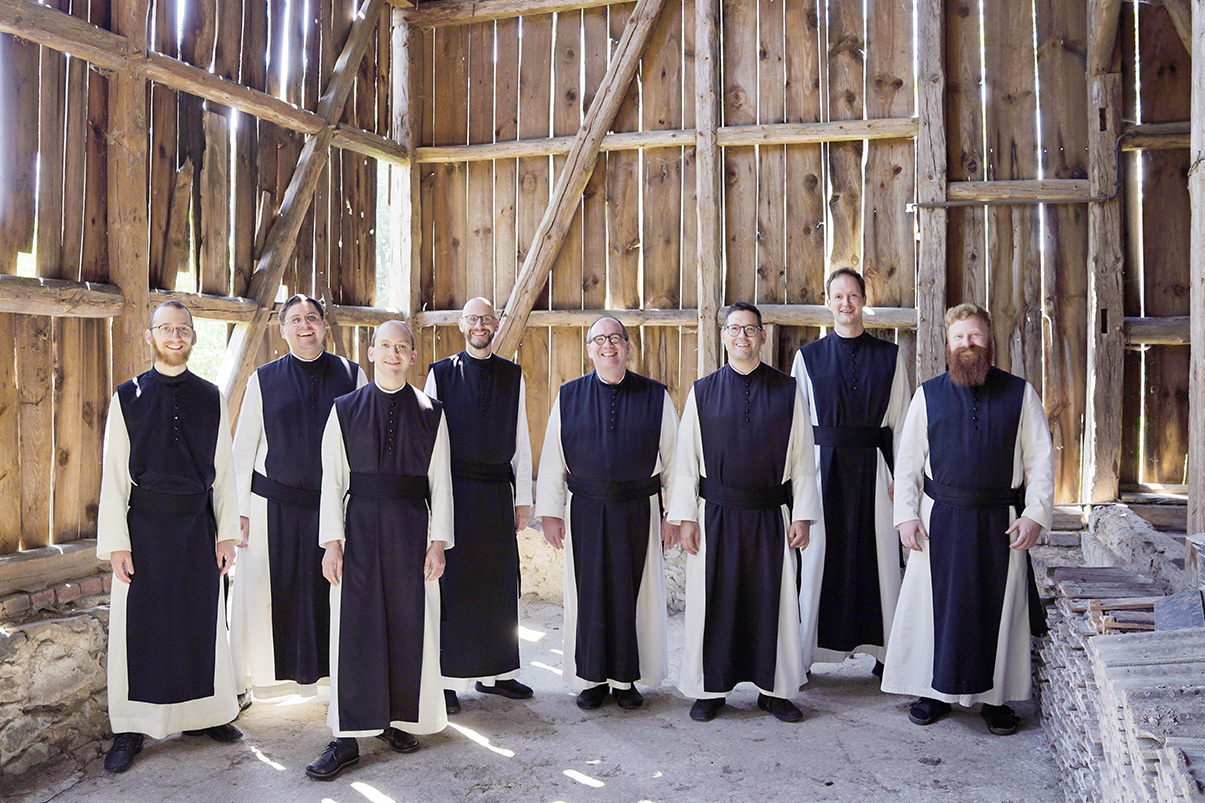The convent of Neuzelle Priory
A dependent priory of Heiligenkreuz Abbey has been established in Neuzelle since September 2, 2018. This makes it the youngest of the three priories of Stift Heiligenkreuz. A dependent priory is a site that continues to belong to the mother monastery in terms of Canonic Law. The confreres in Neuzelle are therefore also subject to the Abbot of Heiligenkreuz. There are two superiors in a priory: the Prior and the Subprior. The convent (community, from the Latin convenire, to come together) of Neuzelle Priory currently consists of seven solemnly professed monks and one temporarily professed monk.
History of the order
Who are the Cistercians?
The name stems from the first monastery “Cistercium“. We Cistercians take our name from the first monastery that was founded in “Cistercium” in France in 1098. In French, this place is now called “Citeaux”. This is why every monastery of our order had “Cistercium Mater nostra” (Cîteaux is our mother) at the gate.
The Cistercians are Benedictine monks, i.e. we live according to the Rule of St. Benedict. Our great father of the order – not our founder though – is St. Bernard of Clairvaux (1090-1153).
The monks of Heiligenkreuz are Cistercians of this original order, the abbreviation of the order’s name is “OCist”, which means “Ordo Cisterciensis”. Characteristic is the black and white habit of the order, which, according to tradition, the Blessed Virgin Mary personally gave to the 2nd Abbot of Citeaux, St. Alberich.
In the 19th century, the Trappists separated from the original Cistercian order and very quickly grew into a large order. They wear a similar habit and call themselves “Cistercians of the Strict Observance”, the abbreviation for which is “OCSO”, which means “Ordo Cisterciensis Strictioris Observantiae“. Although we are two different orders, there is a bond of love and peace between us; Cistercians and Trappists form the main branches of the “Familia Cisterciensis”, as Papst Leo XIII put it.
And besides praying?
What do monks actually do all day?
The answer is: it depends. In any case, community life is characterized by praying in the choir and at mealtimes. According to Benedict’s Rule, however, work is an essential part of the monks’ everyday life – except on Sundays and public holidays. Lectio divina (spiritual reading) is also a daily part of our lives. We read the Bible or books about spiritual matters. But you can also read “normal” books. But they should always be uplifting and not contradict our way of life. Horror novels are therefore not recommended reading for monks.
Every monk is assigned an officium (office, task) by the abbot, which he has to take care of. For example, service in the sacristy, as a cantor, in the kitchen, in the garden or in the administration of the monastery. In most cases, you are assigned several offices, depending on your capacities and abilities.
Monasteries are always places of hospitality. Therefore, one of the most important offices in the monastery is that of guest master. There is even a separate chapter in the Rule of St. Benedict on the reception of guests. It says: “All guests who come should be received as Christ.” (Rule of St. Benedict, 53rd chapter).
In Heiligenkreuz we have also been providing parish pastoral care since the 18th century as a result of Josephinism. This will also be an important field of work in Neuzelle, in all its forms: Pilgrimage, youth, families, prayer circles – whatever is needed.
We also sing a lot, especially Gregorian chant. We have recorded a few CDs in recent years. A recording takes a lot of work for a few days at first. But because this attracts a lot of attention, guests come again. The press contacts have to be coordinated. And sometimes we even get to travel to the Holy Land:
Heiligenkreuz Abbey
A live monastery since 1133
At the request of his son Otto, who had taken the habit at the Cistercian abbey of Morimond in Burgundy, Markgraf Leopold III decided around 1133 to found a Cistercian monastery in the southern Vienna Woods, which was called Sancta Crux, Heiligenkreuz, from the very beginning, and not just since receiving the great relic of the cross in 1187.
In the 12th and 13th centuries, the monastery experienced its first heyday: during this period, the monastery’s estate grew rapidly, with the Babenberg ruling family and the Hungarian kings as well as numerous nobles and citizens becoming prominent patrons. The prosperity of the time is also reflected in the impressive medieval monastery complex, which dates back to the 12th and 13th centuries and has been preserved to this day: the Romanesque church was consecrated in 1187, the monastery complex was rebuilt in early Gothic style in 1220-1240 and the Gothic hall choir and well house were completed in 1295.

Our coat of arms
A new coat of arms for the new Neuzelle monastery
With the canonical establishment of Neuzelle Priory on September 2, 2018, the monastic community of founding monks under the leadership of Father Prior Simeon Wester also gave it a new coat of arms. Designed according to heraldic rules, it was intended to be both simple and eloquent, thus expressing the history and character of the new monastery.
We would like to thank heraldist Rudolf Werner Mader zu Herbede for his competent support and the successful design of the new coat of arms.
Blazon
In gold a red trefoil cross with a silver Jacob’s scallop shell.
The shield is backed with a golden vanguard cloverleaf cross.
Interpretation
The cross with cloverleaf ends has been used in the abbot’s coat of arms of Neuzelle Abbey since the Baroque period. The scallop shell shown on the heart, attribute of our pilgrimage on earth and of the apostle James the Elder, patron saint of the cathedral of the diocese of Görlitz, is taken from the third field of the coat of arms of the Bishop of Görlitz, Wolfgang Ipolt, the initiator of the refoundation of Neuzelle Abbey, and is a reference to the scallop shell in the diocesan coat of arms.
The shape of the shield quotes the Gothic shields of the bishop’s coat of arms and the coat of arms of Heiligenkreuz Abbey. The coat of arms colors shown, red and gold, are also the field colors of the diocesan and bishop’s coat of arms and the coat of arms colors of the mother monastery, Heiligenkreuz Abbey. The coat of arms of Heiligenkreuz Abbey and its daughter monastery Neuzelle both show a Gothic shield with a red cross in gold.


